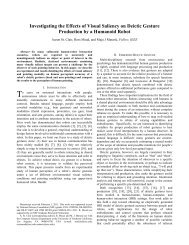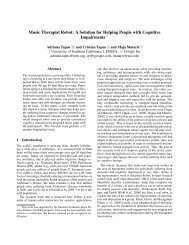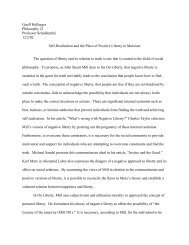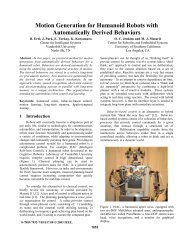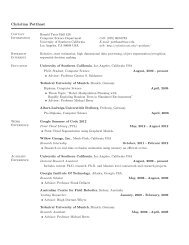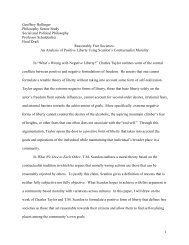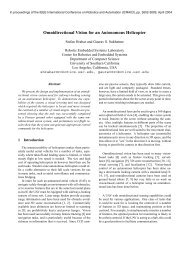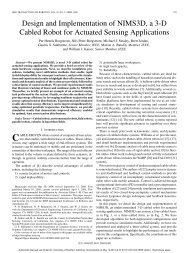A Socially Assistive Robot Exercise Coach for the Elderly
A Socially Assistive Robot Exercise Coach for the Elderly
A Socially Assistive Robot Exercise Coach for the Elderly
You also want an ePaper? Increase the reach of your titles
YUMPU automatically turns print PDFs into web optimized ePapers that Google loves.
Fasola & Matarić. A SAR <strong>Exercise</strong> <strong>Coach</strong> <strong>for</strong> <strong>the</strong> <strong>Elderly</strong>session. Lastly, <strong>the</strong>ir work did not explore <strong>the</strong> agent’s role in actively motivating <strong>the</strong> userto engage in <strong>the</strong> task, and instead focused solely on <strong>the</strong> effect of embodiment. In contrast,our SAR system was designed to engage elderly users in fluid, highly interactive exercisesessions, completely autonomously, while providing active feedback, motivation, andguidance on <strong>the</strong> task. Also, our user study spanned multiple sessions, each lasting 20minutes, <strong>for</strong> <strong>the</strong> dual purpose of system evaluation and comparison between two differentSAR coaching embodiments.The interactivity of <strong>the</strong> sessions is important because, as we discuss in <strong>the</strong> nextsection, <strong>the</strong> fluidity of <strong>the</strong> interaction can have a positive influence on <strong>the</strong> user’s intrinsicmotivation to engage in <strong>the</strong> task and can <strong>the</strong>reby increase his or her enjoyment levelduring interaction. It is thus interesting to investigate whe<strong>the</strong>r <strong>the</strong> positive effectsintroduced by <strong>the</strong> interaction characteristics might somehow alleviate any potentialnegative effects resulting from embodiment characteristics. Our study addresses thispossibility in capturing user evaluations of <strong>the</strong> system between study groups.To <strong>the</strong> best of our knowledge, our user study is <strong>the</strong> first to comprehensivelydemonstrate <strong>the</strong> positive effect of physical embodiment in a SAR-guided healthcarescenario, wherein <strong>the</strong> SAR agent serves as both an instructor and active participant in <strong>the</strong>healthcare task with target users.3. <strong>Robot</strong> <strong>Exercise</strong> <strong>Coach</strong>3.1 Approach and MethodologyOur approach to designing our SAR system to help address <strong>the</strong> physical exercise needs of<strong>the</strong> elderly population was motivated by two basic axioms indicating <strong>the</strong> essentialqualities that <strong>the</strong> SAR agent coach must possess: 1) <strong>the</strong> ability to influence <strong>the</strong> user’sintrinsic motivation to per<strong>for</strong>m <strong>the</strong> task, and 2) <strong>the</strong> ability to personalize <strong>the</strong> socialinteraction to maintain user engagement in <strong>the</strong> task and build trust in <strong>the</strong> task-basedhuman-robot relationship. Following <strong>the</strong> above axioms, we developed five designprinciples <strong>for</strong> <strong>the</strong> SAR system; all are general and can be applied to any SAR-based<strong>the</strong>rapeutic intervention.3.1.1 Design PrinciplesThe design principles stated that <strong>the</strong> robot coach should be as follows: 1) motivating, 2)fluid and highly interactive, 3) personable, 4) intelligent, and 5) task-driven. Thefollowing discussion elaborates on <strong>the</strong> importance of each of <strong>the</strong>se qualities in <strong>the</strong> contextof providing healthcare interventions and details how each was incorporated into ourSAR exercise system.1) Motivating. The coaching style and interaction methodology of our SAR exercisesystem was guided by psychology research in <strong>the</strong> area of intrinsic motivation. Intrinsicmotivation, in contrast to extrinsic motivation, which is driven by external rewards,comes from within an individual and is based on pleasure derived from engaging in anactivity. Specifically, our aim was <strong>for</strong> <strong>the</strong> robot to be capable of increasing <strong>the</strong> user’sintrinsic motivation to per<strong>for</strong>m <strong>the</strong> <strong>the</strong>rapeutic task (physical exercise, in this case).Intrinsic motivation has been shown to be more effective than extrinsic motivation inachieving long-term user task compliance and behavior change (Dienstbier & Leak,1976), which is <strong>the</strong> ultimate goal <strong>for</strong> any health-related intervention, technology-based or5



